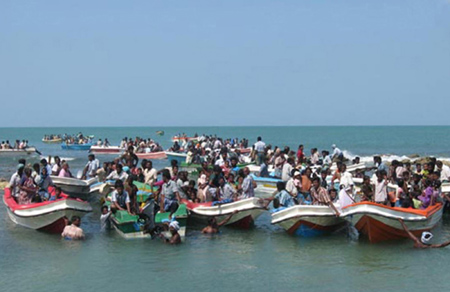The US government released satellite images Tuesday showing about 25,000 tents housing civilians squeezed into the last small strip controlled by the rebels, a coastal strip of about only 8 square miles (21 square kilometers). The State Department estimated about 125,000 people were in the conflict zone before the exodus over the past two days.
|

|
|
In this handout photograph released by the Sri Lankan navy on April 21, 2009 shows what the military says is thousands of people fleeing an area by boats from a beach controlled by the Tamil Tiger separatists in northeastern Sri Lanka. [Agencies]
|
A worker for Doctors Without Borders said hundreds of wounded were arriving at her hospital in Vavuniya, south of the war zone, in government-arranged buses, and some had died en route. The hospital is overcrowded with 1,200 people being accommodated in a facility with only 400 beds, said mental health officer Karen Stewart, according to a statement from the aid group.
UN High Commissioner for Refugees Antonio Guterres was concerned about the "dramatic situation" for civilians still in the war zone, said commission spokesman Ron Redmond.
"There are innocent civilians - women and children - caught in the middle of the conflict ... so the high commissioner is saying there should be a pause in the hostilities and the LTTE should allow civilians to leave," Redmond said.
Military spokesman Brig. Udaya Nanayakkara denied that 1,000 civilians died, saying 17 civilians were killed Monday by rebel shelling and by three suicide bombers.
"Our troops are rescuing the trapped civilians. It's the LTTE which is preventing civilians from fleeing," Nanayakkara said.
It was impossible to get independent accounts of casualties because journalists are restricted from the war zone.
The number of fleeing civilians made it clear that the government had vastly underestimated how many people were caught in the fighting.
"Both sides need to show far greater concern for civilians, or many more civilians will die," said Brad Adams, Asia director for the New York-based group Human Rights Watch.
A final government offensive "could lead to a dramatic increase in the number of civilian casualties," the International Committee of the Red Cross said.

